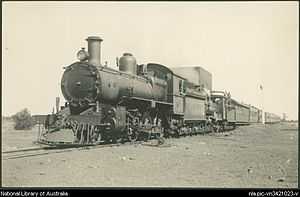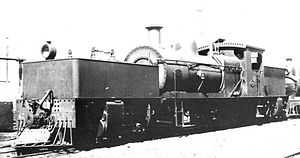WAGR E class
| WAGR E class | |
|---|---|
|
E300 and Ra174 heading the down Kalgoorlie Express at Bullabulling, ca. 1930s. | |
| Type and origin | |
| Power type | Steam |
| Builder |
Nasmyth, Wilson & Co. (15), North British Locomotive Co. (20), Vulcan Foundry (30) |
| Serial number |
NW 641-655 (WAGR 291-305) VF 1844–1873 (306-355) NBL 19604-19623 (336-355) |
| Build date | 1902–1903 |
| Total produced | 65 |
| Rebuild date | 1924–1925 |
| Number rebuilt | 61 (to Es class) |
| Specifications | |
| Configuration | 4-6-2 |
| UIC classification | 2′C1′ n2 |
| Gauge | 3 ft 6 in (1,067 mm) |
| Driver diameter | 4 ft 6 in (1,372 mm) |
| Water capacity | 2,200 imp gal (10,000 l; 2,600 US gal) |
| Boiler pressure | 180 lbf/in2 (1.24 MPa) |
| Firegrate area | 19 sq ft (1.8 m2) |
| Superheater type | None |
| Cylinder size | 17 in × 23 in (432 mm × 584 mm) |
| Performance figures | |
| Tractive effort | 18,833 lbf (83.77 kN) |
| Career | |
| Operator(s) | Western Australian Government Railways |
| Class | E |
The WAGR E class were a type of sixty-five steam-locomotives built for the Western Australian Government Railways 3 ft 6 in (1,067 mm) narrow-gauge network by three British manufacturers Nasmyth, Wilson and Company, Vulcan Foundry, and the North British Locomotive Company, from 1902. The locomotives provided a huge increase in locomotive power available to the WAGR and were the mainstay traction of WAGR passenger services for two decades. The Es class was the name given to a reconstruction of all but four of the class carried out between 1924 and 1925.
Background
In the early 20th Century, the WAGR was using a wide range of locomotives for a variety of operational roles. One type of locomotive lacking, however, was a dedicated long-distance of express passenger locomotive. The R class engines of 1897 had not proved appropriate for the steep gradients made necessary by the crossing of the Darling Scarp, due to their lack of power. In 1902 an order was placed with a number of different locomotive construction companies in England, the Nasmyth, Wilson and Company, Vulcan Foundry, and North British Locomotive for 65 4-6-2 "Pacific" type. These became the WAGR E class locomotives and were the first 4-6-2 locomotives in Australia.[1]
Es class
Sixty-one of these locomotives were rebuilt as Es class in 1924/1925; one example has been preserved. The E and Es class revolutionised the long-distance travel between Perth and Kalgoolie. They were later replaced on this service by the P class in 1924 and again by the Pr class - arguably the most successful and handsome WAGR designs - in 1938.
Operational history
Construction and Introduction
Due to slow delivery times by the British Companies as a result of full-order books and a preference for larger orders, twenty modified E class locomotives were ordered from the United States and became the WAGR Ec class. They differed from the E class in that they were compound engines. The E class eventually totalled sixty-five in number, with 30 examples being built by the Vulcan Foundry, 20 by North British and 15 by Nasmyth, Wilson. The first fifteen entered service between 1903/04 and were successful from the outset, providing a much needed boost to WAGR locomotive power.
See also
- History of rail transport in Western Australia
- List of Western Australian locomotive classes
- WAGR E class (1879) – another class of steam locomotive also designated as the WAGR E class
- WAGR E class (diesel) – a single-member class of (ex-MRWA) diesel-hydraulic locomotive
References
Notes
- ↑ McNicol, S., 1994, WAGR Steam Locomotives in Preservation, Railmac Publications
Bibliography
- Gunzburg, Adrian (1984). A History of WAGR Steam Locomotives. Perth: Australian Railway Historical Society (Western Australian Division). ISBN 0959969039.
External links
![]() Media related to WAGR E class at Wikimedia Commons
Media related to WAGR E class at Wikimedia Commons
| |||||||||||||||||||||||||||||||||||||


